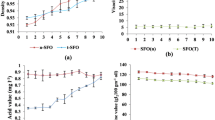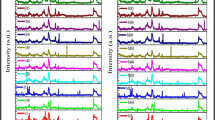Abstract
Current environmental issues and depletion of natural petroleum resources demand alternative fuels for transportation. The present study deals with mixed dairy waste and Karanja oil (DK oils) biodiesel production using Taguchi L9 orthogonal array and characterization of the DK biodiesel blends to study its suitability as a renewable alternative fuel through gas chromatography, infrared spectroscopy, element analysis, physicochemical properties investigation, thermal behavior and combustion analysis using TG–DTG and TG–DSC techniques. Gas Chromatography was carried out to examine the quantification of fatty acid methyl esters, whereas infrared spectroscopy investigates the organic, inorganic, and polymeric contents with their vibrations in different molecular bonds. IS 1448 standard and elemental analysis is followed to examine the physicochemical properties of biodiesel and CHNSO percentage. Thermogravimetric analysis was followed to investigate the thermal behavior of the blends. Thermal analysis provides the information related to the stages of mass loss with temperature and mass loss percentage. The ignition temperature, burnout temperature, maximum combustion rate temperature, final decomposition temperature, ignition index, and comprehensive ignition index are the essential properties of fuel combustion analysis that are studied. Results indicate that the lower concentration of biodiesel in B20 blend provides a higher value of ignition index (1.67 × 10–4 to 3.86 × 10–4 min−1 °C−2) and comprehensive ignition index (2.8 × 10–6 to 1.1 × 10–5 min−1 °C−3) which provides better ignition performance during combustion.



















Similar content being viewed by others
References
Ahmad J, Yusup S, Bokhari A, Kamil RNM. Study of fuel properties of rubber seed oil-based biodiesel. Energy Convers Manage. 2014;78:266–75. https://doi.org/10.1016/j.enconman.2013.10.056.
Sakthivel R, Ramesh K, Purnachandran R, Shameer PM. A review on the properties, performance and emission aspects of the third-generation biodiesels. Renew Sustain Energy Rev. 2017;82:2970–92. https://doi.org/10.1016/j.rser.2017.10.037.
Gülüm M, Bilgin A. Density, flash point and heating value variations of corn oil biodiesel-diesel fuel blends. Fuel Process Technol. 2015;134:456–64. https://doi.org/10.1016/j.fuproc.2015.02.026.
Ashok B, Nanthagopal K, Mohan A, Johny A, Tamilarasu A. comparative analysis on the effect of zinc oxide and ethanox as additives with biodiesel in CI engine. Energy. 2017;140:352–64. https://doi.org/10.1016/j.energy.2017.09.021.
Inggrid M, KristantoA SH. Optimization of transesterification of rubber seed oil using heterogeneous catalyst calcium oxide. AIP Conf Proc. 2015. https://doi.org/10.1063/1.4938308.
Atabani AE, Silitonga AS, Ong HC, Mahlia TMI, Masjuki HH, Badruddin IA, Fayaz H. Non-edible vegetable oils: a critical evaluation of oil extraction, fatty acid compositions, biodiesel production, characteristics, engine performance and emissions production. Renew Sustain Energy Rev. 2013;18:211–45. https://doi.org/10.1016/j.rser.2012.10.013.
Efthymiopoulos I, Hellier P, Ladommatos N, Profili AR, Eveleigh A, Aliev A, Kay A, Lamptey BM. Influence of solvent selection and extraction temperature on yield and composition of lipids extracted from spent coffee grounds. Ind Crops Prod. 2018;119:49–56. https://doi.org/10.1016/j.indcrop.2018.04.008.
Venkatesh BJ. Production of biodiesel from dairy wash water scum through heterogeneous catalyst and performance evaluation of tbc diesel engine for different diesel and methanol blend ratios. MTech. Thesis, Department of Thermal Power Engineering, Centre for Post Graduate Studies, Mysuru. Project:40S_B_MTECH_007. http://www.kscst.iisc.ernet.in/spp/40_series/SPP40S/03_Seminar_Biofuel_Projects/02_MTech_Projects/313_40S_B_MTECH_007.pdf
Watkins M, Nash D. Dairy factory wastewaters, their use on land and possible environmental impacts-a mini review. Open Agric. 2010;4:1–9.
Patel RL, Sankhavara CD. Biodiesel production from Karanja oil and its use in diesel engine: a Review. Renew Sustain Energy Rev. 2017;71:464–74. https://doi.org/10.1016/j.rser.2016.12.075.
Kumar MV, Babu AV, Kumar PR. Review the impacts on combustion, performance and emissions of biodiesel by using additives in direct injection diesel engine. Alex Eng J. 2018;57:509–16. https://doi.org/10.1016/j.aej.2016.12.016.
Shameer PM, Ramesh K, Sakthivel R, Purnachandran R. Biodiesel production through the use of different sources and characterization of oils and their esters as the substitute of diesel: a review. Renew Sustain Energy Rev. 2017;67:1267–81. https://doi.org/10.1016/j.rser.2016.09.117.
Singh SP, Singh D. Biodiesel production through the use of different sources and characterization of oils and their esters as the substitute of diesel: a review. Renew Sustain Energy Rev. 2010;14:200–16. https://doi.org/10.1016/j.rser.2009.07.017.
Atabani AE, Silitonga AS, Badruddin IA, Mahlia TMI, Masjuki HH, Mekhilef S. A comprehensive review on biodiesel as an alternative energy resource and its characteristics. Renew Sustain Energy Rev. 2012;16:2070–93. https://doi.org/10.1016/j.rser.2012.01.003.
Ghazali WNMW, Mamat R, Masjuki H, Najafi G. Effects of biodiesel from different feedstocks on engine performance and emissions: a review. Renew Sustain Energy Rev. 2015;51:585–602. https://doi.org/10.1016/j.rser.2015.06.031.
Knothe G, Razon LF. Biodiesel fuels. Prog Energy Combust Sci. 2017;58:36–59. https://doi.org/10.1016/j.pecs.2016.08.001.
Ferreira EN, Arruda TBMG, Rodrigues FEA, Arruda DTD, Júnior JHS, Porto DL, Ricardo NMSR. Investigation of the thermal degradation of the biolubricant through TGFTIR and characterization of the biodiesel-Pequi (Caryocar brasiliensis) as energetic raw material. Fuel. 2019;245:398–405. https://doi.org/10.1016/j.fuel.2019.02.006.
Zhou J, Xiong Y, Gong Y, Liu X. Analysis of the oxidative degradation of biodiesel blends using FTIR, UV–Vis, TGA and TD-DES methods. Fuel. 2017;202:23–8. https://doi.org/10.1016/j.fuel.2017.04.032.
Marcelo YM, Leandro FC, Ricci TG, Viana LH, Oliveira SC, Junior AM, Oliveira LCS. Thermoanalytical methods in verifying the quality of biodiesel. Biofuels-Status Persp. 2015. https://doi.org/10.5772/59479.
Dweck J, Sampaio CMS. Analysis of the thermal decomposition of commercial vegetable oils in air by simultaneous TG/DTA. J Therm Anal Calorim. 2004;75:385–91. https://doi.org/10.1023/b:jtan.0000027124.96546.0f.
Candeia RA, Freitas JCO, Souza MAF, Conceicao MM, Santos IMG, Soledade LEB, Souza AG. Thermal and rheological behavior of diesel and methanol biodiesel blends. J Therm Anal Calorim. 2007;87:653–6. https://doi.org/10.1007/s10973-006-7861-2.
Santos NA, Tavares MLA, Rosenhaim R, Silva FC, Fernandes VJ, Santos IMG, Souza AG. Thermogravimetric and calorimetric evaluation of babassu biodiesel obtained by the methanol route. J Therm Anal Calorim. 2007;87:649–52. https://doi.org/10.1007/s10973-006-7765-1.
Souza AG, Danta HJ, Silva MCD, Santos IMG, Fernandes VJ, Sinfrônio FSM, Teixeira LSG, Novák CS. Thermal and kinetic evaluation of cotton oil biodiesel. J Therm Anal Calorim. 2007;90:945–9. https://doi.org/10.1007/s10973-006-8199-5.
Oliveira TF, Dweck J. Liquid phase oxidation quantitative analysis of biodiesel/diesel blends by differential TG and DTA. J Therm Anal Calorim. 2018;134:1953–63. https://doi.org/10.1007/s10973-018-7298-4.
Meireles RBRLA, Alcântara MA, Polari ILB, Santos AGSNA, Grisi CVB, Cordeiro AMTM. Catole coconut (Syagrus cearensis) oil: physicochemical characterization and thermo-oxidative stability by TG/DTG/DTA and Rancimat. J Therm Anal Calorim. 2021. https://doi.org/10.1007/s10973-021-10789-0.
Cortes MR, Queiroz JF, Santos TMN, Cavalheiro LF, Misutsu M, Ravaglia LM, Alcantara GB, Vian LH, Nazário CED, Simionatto E, Oliveira LCD. Applying quasi-isothermalthermogravimetry to determine degreesof oil conversion into biodiesel. J Therm Anal Calorim. 2021. https://doi.org/10.1007/s10973-021-10834-y.
Oliveira TP, Santos MFV, Batista ACM, Araújo AMM, Conceição MM, Fernandes VJ Jr, Gondim AD. CaO–TiO2 bimetallic mixed oxideapplied to the production of biodiesel from cotton oil (Gossypium hisutum): monitoring of the procedure by TGA. J Therm Anal Calorim. 2021. https://doi.org/10.1007/s10973-021-10624-6.
More GV, Rao YVH. Biodiesel production with the help of different additives on the basis of standards-a Review. J Adv Res Dyn Control Syst. 2018;10:2050–64.
Onoji SE, Iyuke SE, Igbafe AI, Nkazi DB. Review: rubber seed oil: a potential renewable source of biodiesel for sustainable development in sub-Saharan Africa. Energy Convers Manage. 2016;110:125–34. https://doi.org/10.1016/j.enconman.2015.12.002.
Morshed M, Ferdous K, Khan MR, Mazumder MSI, Islam MA, Uddin MT. Rubber seed oil as a potential source for biodiesel production in Bangladesh. Fuel. 2011;90:2981–6. https://doi.org/10.1016/j.fuel.2011.05.020.
Krishnamurthy KN, Sridhara SN, Kumar CSA. Synthesis and optimization of Hydnocarpus wightiana and dairy waste scum as feedstock for biodiesel production by using response surface methodology. Energy. 2018;153:1073–86. https://doi.org/10.1016/j.energy.2018.04.068.
Yesilyurt MK, Cesur C. Biodiesel synthesis from Styrax officinalis L. seed oil as a novel and potential non-edible feedstock: a parametric optimization study through the Taguchi technique. Fuel. 2020;265:117025. https://doi.org/10.1016/j.fuel.2020.117025.
Ross PJ. Taguchi techniques for quality engineering. Singapore: McGraw-Hill; 1989.
Almazrouei M, Janajreh I. Thermogravimetric study of the combustion characteristics of biodiesel and petroleum diesel. J Therm Anal Calorim. 2019;136:925–35. https://doi.org/10.1007/s10973-018-7717-6.
Lu JJ, Chen WH. Investigation on the ignition and burnout temperatures of bamboo and sugarcane bagasse by thermogravimetric analysis. Appl Energy. 2015;160:49–57. https://doi.org/10.1016/j.apenergy.2015.09.026.
Peng C, Zhai Y, Zhu Y, Xu B, Wang T, Li C, Zeng G. Production of char from sewage sludge employing hydrothermal carbonization: char properties, combustion behavior and thermal characteristics. Fuel. 2016;176:110–8. https://doi.org/10.1016/j.fuel.2016.02.068.
Vamvuka D, Chatib NE, Sfakiotakis SI. Measurements of ignition point and combustion characteristics of biomass fuels and their blends with lignite. Proceedings of the European Combustion Meeting. 2011. https://www.researchgate.net/publication/232168026
Li XG, Lv Y, Ma BG, Jian SW, Tan HB. Thermogravimetric investigation on co-combustion characteristics of tobacco residue and high-ash anthracite coal. Biores Technol. 2011;102:9783–7. https://doi.org/10.1016/j.biortech.2011.07.117.
Ahn S, Choi G, Kim D. The effect of wood biomass blending with pulverized coal on combustion characteristics under oxy-fuel condition. Biomass Bioenerg. 2014;71:144–54. https://doi.org/10.1016/j.biombioe.2014.10.014.
Zhang B, Fu P, Liu Y, Yue F, Chen J, Zhou H, Zheng C. Investigation on the ignition, thermal acceleration and characteristic temperatures of coal char combustion. Appl Therm Eng. 2017;113:1303–12. https://doi.org/10.1016/j.applthermaleng.2016.11.103.
Shanab RAIA, Hwang JH, Cho Y, Min B, Jeon BH. Characterization of microalgal species isolated from fresh water bodies as a potential source for biodiesel production. Appl Energy. 2011;88:3300–6. https://doi.org/10.1016/j.apenergy.2011.01.060.
Bagul SY, Bharti KR, Dhar DW. Assessing biodiesel quality parameters for wastewater grown Chlorella sp. Water Sci Technol. 2017;76:719–27. https://doi.org/10.2166/wst.2017.223.
Roschat W, Siritanon T, Yoosuk B, Sudyoadsuk T, Promarak V. Rubber seed oil as potential non-edible feedstock for biodiesel production using heterogeneous catalyst in Thailand. Renew Energy. 2017;101:937–44. https://doi.org/10.1016/j.renene.2016.09.057.
Oyerinde AY, Bello EI. Use of fourier transformation infrared (FTIR) spectroscopy for analysis of functional groups in peanut oil biodiesel and its blends. Br J Appl Sci Technol. 2016;13(3):1–14. https://doi.org/10.9734/BJAST/2016/22178.
Hohn B. Haywood. Internal combustion engine fundamentals. 11th ed. McGraw Hill Education; 2015.
Fuels and Combustion. Bureau of energy efficiency. https://beeindia.gov.in/sites/default/files/2Ch1.pdf.
Hasannuddin AK, Yahya WJ, Sarah S, Ithnin AM, Syahrullail S, Sugeng DA, Razak IFA, Fatah AYA, Aqma WS, Rahman AHA, Ramlan NA. Performance, emissions and carbon deposit characteristics of diesel engine operating on emulsion fuel. Energy. 2018;142:496–506. https://doi.org/10.1016/j.energy.2017.10.044.
Gimbun J, Ali S, Kanwal CCSC, Shah LA, Ghazali NHM, Cheng CK, Nurdin S. Biodiesel production from rubber seed oil using a limestone based catalyst. Adv Mater Phys Chem. 2012;2:138–41. https://doi.org/10.4236/ampc.2012.24B036.
Krishnakumar U, Sivasubramanian V, Selvaraju N. Physico-chemical properties of the biodiesel extracted from rubber seed oil using solid metal oxide catalysts. Int J Eng Res Appl. 2013;3:2206–9.
Yang R, Su M, Zhang J, Jin F, Zha C, Li M, Hao X. Biodiesel production from rubber seed oil using poly (sodium acrylate) supporting NaOH as a water-resistant catalyst. Biores Technol. 2011;102:2665–71. https://doi.org/10.1016/j.biortech.2010.10.131.
Ahmad J, Yusup S, Bokhari A, Kamil RNM. Biodiesel Production from the high free fatty acid hevea brasiliensis and fuel properties characterization. Appl Mech Mater. 2014;625:897–900.https://doi.org/10.4028/www.scientific.net/AMM.625.897
Rahees K, Meera V. Production of biodiesel from dairy waste scum. Int J Sci Eng Res. 2014;5:194–9.
Yatish KV, Lalithamba HS, Suresh R, Arun SB, Kumar PV. Optimization of scum oil biodiesel production by using response surface methodology. Process Saf Environ Prot. 2016;102:667–72. https://doi.org/10.1016/j.psep.2016.05.026.
Sandeep G, Dattatreya G, Lakshmi SRS, Kumar NS, Venkatesh P. Karanja oil as an alternative fuel with air preheater. Int J Mech Eng Technol. 2017;8:218–25.
Fadhil AB, Tikrity ETBA, Albadree MA. Biodiesel production from mixed non-edible oils, castor seed oil and waste fish oil. Fuel. 2017;210:721–8. https://doi.org/10.1016/j.fuel.2017.09.009.
More GV, Koli SR, Rao YVH, Prasad PI, Rao BN. Effect of compression ratio on compression ignition engine with RUCO biodiesel/ diethyl ether/ diesel fuel blends. Energy sources, part a: recovery, utilization, and environmental effects. 2020. https://doi.org/10.1080/15567036.2020.1785593
Venkatesan K, Sathyaraj S. Performance and emission characteristics of cashew nut shell pyrolysed oil: waste cooking oil with diesel fuel in a four stoke di diesel engine. Int J Mech Prod Eng Res Dev. 2018;8:181–8.
Acknowledgements
The authors would like to acknowledge the Sophisticated Analytical Instrument Facility (SAIF), IIT Bombay, Mumbai-400076, Maharashtra, India; Sophisticated Analytical Instrument Facility (SAIF), IIT Madras, Tamil Nadu-600036, India and Nirmala Innovations and Incubation Centre, Nirmala College of Pharmacy, Mangalagiri-522503, Andhra Pradesh, India for providing facilities to conduct experiments.
Funding
This work is not supported fully or partially by any funding organization or agency.
Author information
Authors and Affiliations
Corresponding author
Ethics declarations
Conflict of interest
The authors declare that there is no conflict of interests regarding the publication of this paper.
Additional information
Publisher's Note
Springer Nature remains neutral with regard to jurisdictional claims in published maps and institutional affiliations.
Rights and permissions
About this article
Cite this article
More, G.V., Hanumantha Rao, Y.V., Kedar, S.A. et al. Biodiesel production from DK oils using Taguchi L9 techniques: characterization and thermogravimetric study of combustion characteristics. J Therm Anal Calorim 147, 7043–7062 (2022). https://doi.org/10.1007/s10973-021-11020-w
Received:
Accepted:
Published:
Issue Date:
DOI: https://doi.org/10.1007/s10973-021-11020-w




